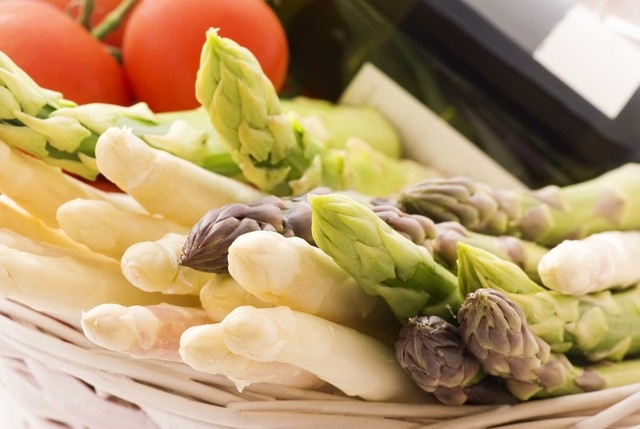Spring’s arrival brings bounty of fresh, flavorful new crops

Spring has sprung, which means spring produce is sprouting up all over.
“There’s a lot of stuff happening,” said Wes Kendrick, executive chef at Table 34.
“It’s a great time to start hitting the farmers markets,” said Kim Canteenwalla, chef/owner of Honey Salt and executive chef of Buddy V’s Ristorante at the Grand Canal Shoppes.
But some of it won’t be in the market for long.
Todd Clore, chef/owner of Todd’s Unique Dining in Henderson, said the first of the spring produce came in just last week. Among it, he said, was white asparagus, for which the season will be short.
“Maybe two or three weeks — not a huge amount of time,” Clore said.
He said he poaches white asparagus in salted water and serves it as a salad with chives, egg yolks and lemon vinaigrette.
“That’s a nice spring thing,” Clore said.
Canteenwalla said white asparagus is a “traditional classic.”
“I used to wait for spring,” he said. “Traditionally it was always served with a mousseline, or Hollandaise with some truffle added to it. You have to cook it a lot longer than green asparagus, it’s so woody at the bottom.”
Kendrick said he’s been getting purple asparagus, from Peru, as well as green and white. He said he uses it as a plate vegetable.
“It’s not really good raw,” he said. “If you blanch it, it kind of holds its color better.”
They’re getting ramps, too, which are often called wild leeks.
“We’ll sweat those,” Clore said, “and serve them with all kinds of grilled fishes. We’ll also make a ramp emulsion, where we’ll roast them off almost to confit and then puree them with a little bit of olive oil and lemon juice.”
Canteenwalla said ramps won’t be around long, either.
“We will pickle them when the season starts to dwindle down,” he said.
Spring’s the season for artichokes as well, and the chefs have been using them in both familiar and not-so-familiar ways. Canteenwalla said in the early days of Buddy V’s, and when he was executive chef at Society at Encore, he used to roast artichokes and serve them with a spicy aioli for dipping. On a recent evening at Honey Salt, he said, he changed that up a bit by marinating artichoke hearts in a spicy mixture and serving them without the aioli.
“We finished them with the last blood orange from our tree,” he said.
Heirloom tomatoes are starting, too.
“They’ve been a little spotty, but the new market report is looking good,” Kendrick said. He’s using them in a caprese salad with organic sprouts from Las Vegas’ R Fish &Veggies, fresh basil and smoked mozzarella.
“It’s a little variation, but it’s really nice,” he said of the smoky cheese. “I’ve gotten a good response on it.”
Clore also is using heirloom tomatoes in a caprese salad, with fresh mozzarella and a balsamic “cloud.”
“It’s almost like a balsamic foam,” he said. “It’s kind of unexpected. You see this puffy thing and you don’t know what to expect.”
Heirloom tomatoes especially lend themselves to simple preparations, the chefs said.
“As we know, the commodity tomatoes really aren’t that good,” Kendrick said. “So when you get something special, people like to taste the tomato.”
Canteenwalla said Honey Salt has made some changes that take advantage of the fresh spring produce.
“We have a Taste of Honey menu which runs weekly, a three-course set menu,” he said. “We play off that with everything that’s coming in that’s fresh and seasonal. Also, on every second Monday, we do a Farm Table, a community table, with farm products and seasonal products.”
Of which there are plenty, including peas.
“Peas are one of my all-time favorites,” Canteenwalla said.
He’s using them on a crudite toast.
“We crush the peas, make a ricotta mix with lemon and virgin olive oil and finish with pea tendrils and pea shoots,” he said.
At Pebble Beach Food &Wine this week, his plan is to serve toasts with concentrated tomatoes.
“And we’re doing all these springlike vegetables on it, from asparagus tips to ramps and fiddlehead ferns,” he said. “All these springlike, crunchy vegetables that will sit on the concentrated tomato.”
Canteenwalla said that while many of these vegetables are available year-round because they’re shipped from other climates, the local (or nearly local) products of spring are best.
“It’s just a great time,” he said. “Garlic scapes are out all the time now,” as well as leeks, rhubarb and fennel. “This is their peak season.”
GRILLED ASPARAGUS WITH ROMESCO SAUCE
1½ pounds asparagus, trimmed and blanched
Olive oil
¾ cup roasted red pepper, drained and chopped
2 tablespoons sun-dried tomatoes packed in oil, chopped
2 slices baguette (1 inch thick), toasted and torn into pieces
2 tablespoons slivered blanched almonds, toasted
1 clove garlic, chopped
½ tablespoon white vinegar
½ tablespoon flat leaf parsley, chopped
1/8 teaspoon salt
1/8 teaspoon crushed red pepper
Lemon zest for garnish
Brush asparagus with olive oil. On an outdoor or stove-top grill over medium-high heat, grill asparagus, turning frequently, until lightly browned and fork-tender, 5 to 10 minutes. Lightly season with salt and pepper. Cool.
In a food processor, puree roasted red bell pepper and next eight ingredients. With machine running, drizzle in 1½ tablespoons olive oil. If necessary, thin with 1 tablespoon water at a time, until a thick, saucelike consistency is achieved.
To serve, arrange asparagus on a serving platter. Serve with Romesco sauce and garnish with lemon zest.
— Recipe adapted from the California Asparagus Commission
BEER-BATTERED ASPARAGUS WITH THREE SAUCES
2 cups pilsner or other light-flavored beer
½ cup cornstarch
1½ cups flour
1 teaspoon salt
½ teaspoon pepper
1 tablespoon paprika
Peanut or canola oil for deep-frying
Salt and pepper
3 pounds asparagus, ends trimmed
Sauces (recipes follow)
Heat deep fryer to 375 degrees. Combine first six ingredients in blender and blend until well mixed.
Transfer batter to medium bowl. Dip asparagus in batter and deep-fry until golden brown and tender, about 2 to 3 minutes. Drain on paper towels and season with salt and pepper, to taste. Serve warm with sauces.
Sauces:
To make jalapeno ketchup, mix 1 cup ketchup with 1 teaspoon minced grilled fresh jalapeno, 1 teaspoon minced chipotle in adobo, 1 teaspoon lime juice and 1 tablespoon olive oil, salt and pepper, to taste.
For curry dip, mix ½ cup yogurt with ½ cup mayonnaise. Add 1 teaspoon yellow curry powder, 1 teaspoon chopped ginger and salt and pepper, to taste.
To make Parmesan herb dip, mix ½ cup mayonnaise with ½ cup sour cream and ¼ cup buttermilk. Add 1 tablespoon chopped fresh chives, marjoram and Italian parsley. Add 3 tablespoons grated Parmesan, 1 teaspoon lemon juice, and salt and pepper, to taste.
— Recipe from the California Asparagus Commission
BABY ARTICHOKE CHICKEN SAUTE
16 baby artichokes
¼ cup olive oil
4 chicken breasts, skinned, boned and cut into chunks
2 red or yellow onions, thickly sliced
4 cloves garlic, minced
1 tablespoon each chopped fresh basil and rosemary (or 1 teaspoon each dried basil and rosemary, crushed)
½ cup chicken broth
1 pound fettuccine, cooked and drained
To prepare the baby artichokes, which are completely edible, bend back the outer petals, snapping them off at the base. Continue snapping off petals until the leaves are half green (at the top) and half yellow. Using a stainless-steel knife to minimize discoloration, cut the top cone of the leaves at the point where the yellow meets the green. Cut the stem level with the base and trim any remaining green from the base. Plunge into acidified water (1 tablespoon vinegar or lemon juice per quart of water).
Brown chicken in large skillet with 2 tablespoons oil; remove from pan and set aside.
Add remaining 2 tablespoons oil and saute onions until tender.
Add artichokes to skillet with garlic, basil and rosemary.
Cook until artichokes are tender, about 5 minutes.
Stir in browned chicken and drizzle with chicken broth; heat through.
Salt and pepper to taste, if desired.
Serve over hot fettuccine.
Makes 4 servings.
— Recipe from the California Artichoke Advisory Board
GRILLED ARTICHOKES
4 large artichokes
¼ cup balsamic vinegar
¼ cup water
¼ cup soy sauce
1 tablespoon minced ginger
¼ cup olive oil
Slice artichoke tops off, crosswise. Trim stems. Boil or steam artichokes until bottoms pierce easily, or a petal pulls off easily. Drain artichokes. Cool.
Cut each artichoke in half lengthwise and scrape out fuzzy center and any purple-tipped petals.
Mix remaining ingredients in a large plastic bag. Place artichokes in the bag and coat all sides of the artichokes. For best flavor, marinate in the mixture overnight in the refrigerator, but marinate for at least an hour.
Drain artichokes.
Place cut-side down on a grill over a solid bed of medium coals or a gas grill on medium. Grill until lightly browned on the cut side, 5 to 7 minutes. Turn artichokes over and drizzle with some of the remaining marinade. Grill until petal tips are lightly charred, 3 to 4 minutes more.
Serve hot or at room temperature
Serves 8.
— Recipe from the California Artichoke Advisory Board
Contact reporter Heidi Knapp Rinella at hrinella@reviewjournal.com or 702-383-0474.


















